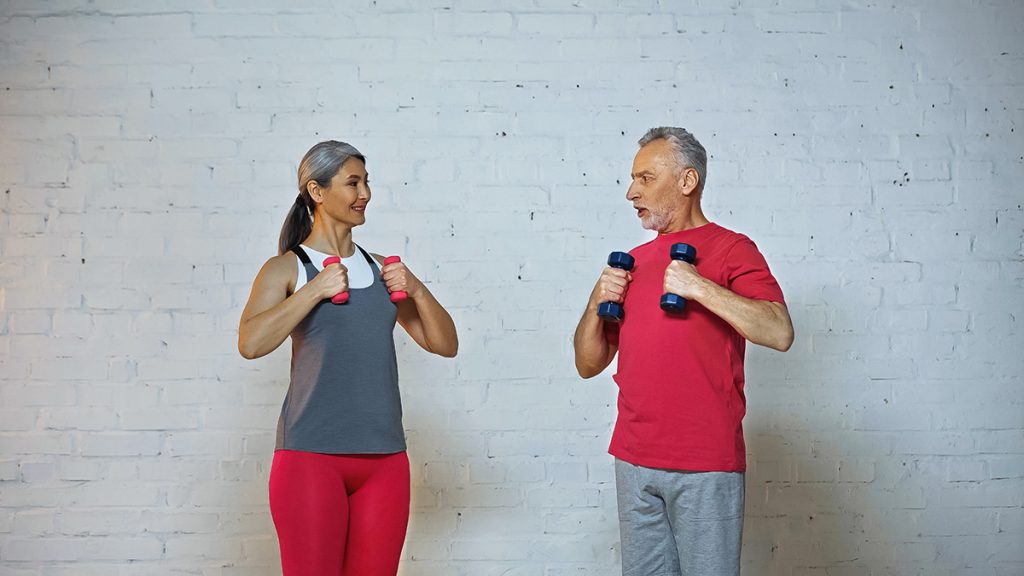Fitness: Establishing Your Program – Setting Your Course
I think of training, not working out. Working out is simply doing something without any identifiable purpose in mind. I believe training must be accompanied by commitment and a deep desire to accomplish something specific that is meaningful to you and worthy of sacrifice. In establishing a fitness program that will work for you and ultimately be successful you need to carefully consider many variables and understand their importance to your eventual outcome. This article will highlight some of my thoughts on this process/subject and hopefully illuminate for you the path forward so that you might enjoy a long and happy – and fit life.

Setting your course – effective goal setting
Setting goals is probably the most important aspect of designing a program since it gives focus and direction to the reasons behind the activities that you ultimately select – and that will work for you. First remember a key idea: If what you choose to do is not fun you will not find your time well spent or get the results you desire. The way to think about setting proper goals is to not to think of “cosmetic fixes” but instead to try to imagine yourself doing the things in your life that would bring you joy, pleasure, a sense of accomplishment, and the happy memories that we carry into our future.
An example in my own life is the wonderful time I had in Japan on four different occasions visiting my daughter Lisa. I took many journeys while there and enjoyed all of them immensely because I was free to explore and spend time among the temples of Kyoto and other historic and wonderful places. I walked for hours without ever getting tired because I am so fit from years of running. Every trip while there was an incredible experience, filled with wonder and beauty. Going forward I hope to have many more adventures and create many wonderful memories I can share with my grandson and Lisa too.
Take your time when evaluating what it is you want to achieve and consider carefully what you want to do to accomplish your goals – and make them performance based. Losing weight is never a sustainable goal because there is no real payoff at the end and one never reaches a happy outcome simply from losing weight. I was taught a simple yet effective method for setting goals and it is called the RAMS method: Reasonable, achievable, measurable, and specific. My goal of running a 6 minute mile on my 80th birthday is already an accomplished fact since I can do it now. If I am alive and well on that birthday I plan on doing that mile!
Programming
Consider this a four step process:
- Evaluate and investigate your options
- Make your choices – cardio, resistance, stretching, nutrition etc.
- Implement your choices on a schedule
- Evaluate and measure your progress (record keeping)
Cardiovascular conditioning
Consider this your “core activity” since it is the one that will consume more of your time. Options include running (my love), walking (the most common option), cycling (indoors and outdoors), swimming, cross country skiing (high calories burning among the options – includes running), and many endurance activities tied to sports related training. There are many ways to train your heart but the most important fact is that to train it effectively you must do something to it over time, at higher intensities that allow your heart to work at higher levels than normal. Establishing those levels will take professional input so do ask for the proper assistance from a qualified professional.
There are target heart rates, stroke volumes, cardiac output, breathing, monitoring fatigue, getting proper rest and recovery and much more to consider. I will cover this and other subjects more directly in later articles. Suffice it to say that if you don’t enjoy your chosen activity you won’t keep doing it. Quitting is quite common in the world and I don’t believe quitting ever solved anything! The most common question fitness professionals get is: Which exercise is the best one? My answer is always the same: The one that you will do! Approximately two thirds of your time should be dedicated to training your heart – it is the organ that will ultimately carry you to your future!
Resistance Training
Resistance training builds lean muscle mass and creates a higher resting metabolic rate (the rate at which the body burns calories at rest). As we age we lose muscle mass at the rate of 2-5 pounds per decade after 20. If you want a body that works efficiently, feels strong, helps you accomplish the tasks of life, and supports your skeletal system and organs without getting injured or sick getting strong is a must. Lean muscle mass is directly tied to burning sugar and eliminating the threat posed by diabetes.

Resistance training strengthens the connective tissue (ligaments, tendons), protects the joints and creates symmetry between the inner and outer processes of the body. If you want to become lean – create a resistance training program (again professional help is recommended) that supports what you want to do in life. For me – weight training is primarily designed to keep me running for years to come. I focus all my energy twice a week building all my major muscle groups and monitor my results in writing (I do this for my running sessions as well). After the age of forty I recommend an increased volume of resistance training because loss of lean muscle mass accelerates as a result of the aging process.
Flexibility
Flexibility protects the joints from damage by balancing the loads place upon them and is a key to aging well. Older people tend to get stiff and bent as they age and weakness in the legs is a constant reminder that falling is a major cause of death among the elderly. Breaking a hip in a fall can be something the older individual does not recover from and could have been avoided with a proper stretching and balance program.
With my older clients I always dedicated at least 20-30 percent of their sessions to balance and flexibility work to insure that they were comfortable just moving. I monitored their gait, posture, balance and other variables for possible negative outcomes. Changing behaviors and attitudes as we age is challenging. I find this true in my own case as I face my own challenges going forward but as one of my favorite teachers said years ago: “Change is the only constant in the natural order” and its corollary: “The mind of man is unlimited in its potential and responds to the specific demands made upon it”. I try to remember that there is always a way to change – we just have to be flexible in our thinking and our behavior to make the necessary changes that could ultimately save our lives.
I always try to remember that the gift I have been given to train for all these decades can be taken away in an instant so I always approach my own training each day with an attitude of deep gratitude and never forget to say thank each day for these gifts. I am grateful every day and never try to forget that an open mind and open heart will get me through almost anything in life. Everything that happens to me is an opportunity for me to learn something new about myself. I will always be a student – I will never know everything and this thought frees me to explore my potential every time I set my sights on new goals and dreams – like this one writing for you.
The FITT Formula
Remember Rome wasn’t built in a day and neither will your body. Changing variables one at a time will allow you the chance to see how your body – and mind – responds to the stimuli you are providing it by your training activities. The FITT formula is something to keep in mind. The letters stand for frequency – how often you do something, intensity – how hard you do something, time – the amount of time you schedule for training activity, and type – the mode or vehicle you select to train. I believe change comes most effectively in “baby steps”. Never ask your body to do more than it can for it will grow as fast as it can, plateau, and then grow some more.
Rest and recovery are crucial to this process – allow time for your body to heal and rest. Overtraining is just as bad – or worse – than undertraining. Go slowly toward goals as your patience will be rewarded with renewed energy, stamina, and happiness in the results you are seeing from your efforts. Reward yourself as you reach new levels and never forget to be grateful for everything and anything that you accomplish. This “consciousness” will serve you well over the years to come!
Nutrition and Weight Management
I won’t speak here on this subject in detail since it is way too complicated for our purposes at this time. Suffice it to say “you are what you eat, you are what you think, you are what you believe, you are what you do and you are your expectations.” What you think about, comes about (Walt Disney – one of my favorite creative geniuses), what you see is what you get and so much more. Eating well yields a truly flexible, strong and happy body. I will say this: Eat a salad, drink water and take a walk”. Eat more fruits and vegetables, whole grains, nuts and seeds and beans and healthy protein – and drink lots of water. More on this later. Please remember that everything you eat creates – or destroys – your future health.
Conclusion and Tips
Be aware of your life as it is today. DO see your doctor for an evaluation for your readiness to train and engage in prolonged physical activity. Ask yourself the tough questions that only you can answer. Be considerate and forgiving of yourself so that you can move forward without guilt or recrimination. Become flexible in mind and body. Start now – don’t wait – because tomorrow is never guaranteed and life is very fragile. Take each step and listen attentively – both inside and outside – to those who want to assist you along the way. Take everything with a “grain of salt” because there are no absolutes when it comes to your own needs, wants, and dreams. Change is constantly influencing the events and circumstances of our lives so no one truly “knows” what is best for you – only you can determine this. Be smart and critical in your thinking and question what you don’t understand. I learn something new every day and I am certainly not ashamed to share with you that I consider myself a “student of running” even though I have been running for 52 years! Travel well!
Nicholas Prukop is an ACE Certified Personal Trainer & a Health Coach, a fitness professional with over 25 years of experience whose passion for health and fitness comes from his boyhood in Hawaii where he grew up a swimmer on Maui. He found his calling in writing his first book “Healthy Aging & You: Your Journey to Becoming Happy, Healthy & Fit” and since then he has dedicated himself to empowering, inspiring and enabling people of all ages to reach for the best that is within them and become who they are meant to be – happy, healthy and fit – and be a part of a world where each person can contribute their own unique gifts to life.

